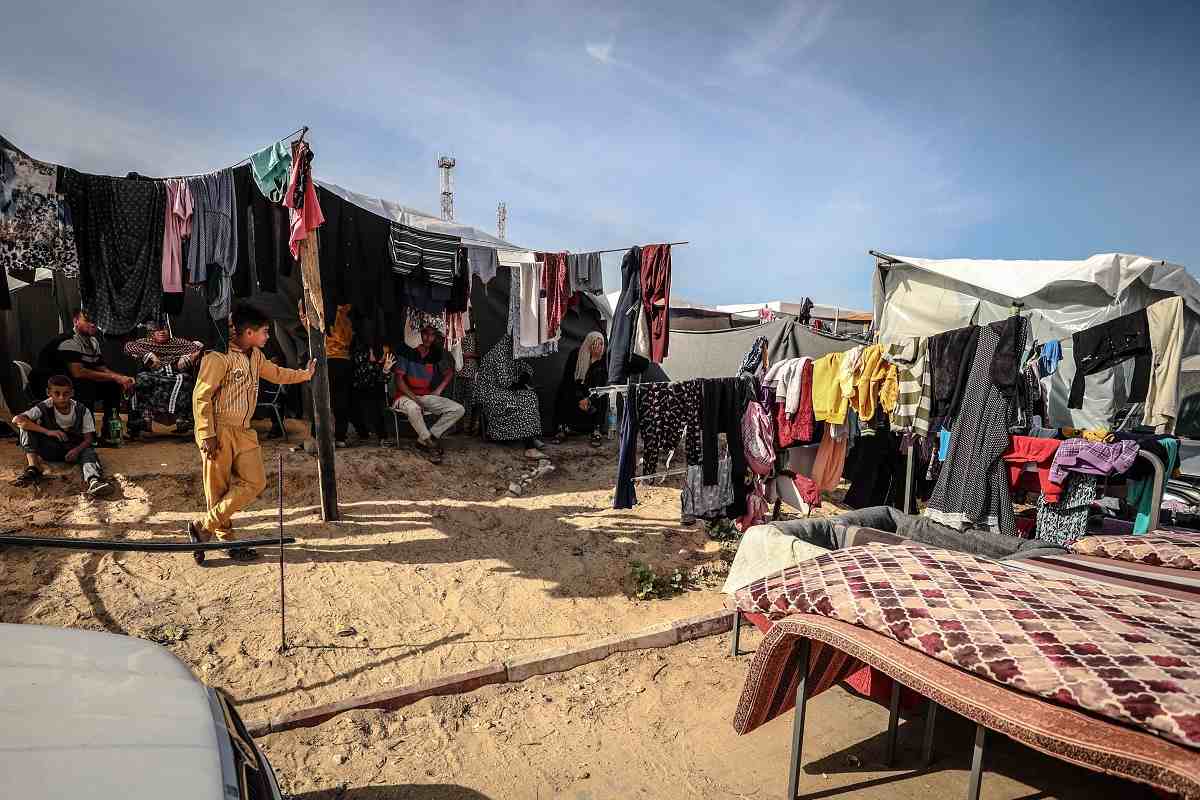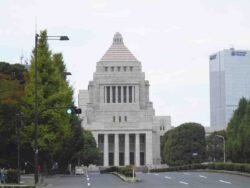
Palestinian families use tents for the displaced in Khan Younis, southern Gaza, on Saturday.
13:49 JST, November 14, 2023
TEL AVIV – The standoff between Israeli troops and Hamas militants intensified Monday around hospitals in the northern Gaza Strip, as the situation grew more desperate for vulnerable civilians caught in the fighting.
Israel maintains Hamas fighters are operating out of buildings designated for humanitarian purposes – including medical facilities, schools and mosques. Doctors, first responders and the few aid workers still left in the area have denied giving cover to militants and are pleading with the international community for a cease-fire.
In the past three days, at least 32 people, including three babies from the intensive care unit, have died at al-Shifa, Gaza’s largest hospital, which is surrounded by Israeli troops, Medhat Abbas, spokesman for the Gaza Health Ministry, said Monday.
He said at least 100 bodies were decomposing in the hospital complex – with about 50 inside the hospital and dozens more in morgues that have run out of power. The ministry was unable to update its death toll, he said, because it had no way to access or keep in reliable touch with the few hospitals still functioning.
Without electricity to power incubators, all premature babies at Shifa have been gathered together to keep them warm. “I hope they will remain alive despite the disaster this hospital is passing through,” he said.
For each side, hospitals have become a symbol of the enemy’s inhumanity – with Israelis accusing Hamas of using the sick and injured as human shields and Palestinians accusing the Israeli army of targeting medical facilities to exact revenge on a beleaguered civilian population.
On Sunday, the head of the World Health Organization, Tedros Adhanom Ghebreyesus, said that without electricity for three days, Shifa “is not functioning as a hospital anymore.” He insisted that health facilities should be havens and not “scenes of death, devastation and despair.”
Al-Quds Hospital, the second largest in the enclave, was surrounded Monday by Israeli forces and unable to evacuate its 300 remaining patients and medical workers because of Israeli bombardments and gunfire, Nebal Farsakh, a spokeswoman for the Palestine Red Crescent Society, which runs the hospital, said from the West Bank city of Ramallah.
The hospital has been almost entirely cut off for six days, Farsakh said. The team had communicated with al-Quds workers on radios connected to the hospital’s ambulance system but lost touch Monday morning, she said.
The Israel Defense Forces said in a statement that a “terrorist squad embedded itself in the area of the ‘Al-Quds’ Hospital, fired from the hospital entrance at IDF soldiers, and was subsequently eliminated.” Twenty-one militants were killed, the IDF said.
On Sunday, a guesthouse belonging to the U.N. refugee agency for Palestinians, UNRWA, in Rafah, in the southern Gaza Strip, was hit by Israeli naval strikes, though there were no workers in the building.
“The disregard for the protection of civilian infrastructure including U.N. facilities, hospitals, schools, shelters and places of worship is testament to the level of horror that civilians in Gaza are living every day,” UNRWA Commissioner General Philippe Lazzarini said.
Hamas has denied Israeli claims that Shifa sits atop a Hamas headquarters. Medical personnel have said that the large complex is home only to an overwhelming number of wounded Gazans and resource-strapped doctors struggling to treat them.
Abbas, of the health ministry, said the hospital was still also housing 8,000 displaced people with dwindling food and was “under complete siege.” Amputations were being done “without anesthesia.” Though the Israeli army had told people they would be ensured safe passage on a road that was cleared of tanks, Abbas said “the planes target anyone who tries to leave the hospital.”
Last month, IDF spokesman Daniel Hagari told reporters that Hamas is using the hospital complex as a main command center to house its top leaders and arsenals and uses the center’s “4,000 staff members as a human shield.”
The hospital has “several underground complexes, used by the leaders of the terrorist organization Hamas to direct their activities, and a tunnel that reaches the hospital and allows entrance to the Hamas headquarters without going through the hospital,” Hagari said.
The Washington Post could not independently verify the claims by Israel or the Health Ministry.
U.S. officials are increasingly concerned about the heavy toll of the conflict on civilians and have publicly called on Israel to address the suffering of noncombatants.
Biden administration officials say Israel is justified in dismantling Hamas as a security threat, but they hope it can be done quickly before public anger over the humanitarian crisis further erodes Israel’s support around the world. The officials spoke on the condition of anonymity to discuss their sensitive calculations on the subject.
Israeli foreign minister Eli Cohen acknowledged to Israeli reporters Monday that international pressure is building, but he estimated the country still has a two- or three-week “diplomatic window,” local media reported.
Negotiations over the release of the estimated 240 Israeli and foreign hostages held by Hamas are “continuing to make progress day by day, hour by hour,” White House national security adviser Jake Sullivan said Monday. “Qatar is talking to Hamas, Israel is talking to Qatar, the United States is talking to both.”
His remarks followed comments by President Biden that “there is an effort to get this pause” in the fighting in Gaza “to deal with the release of prisoners.”
“We have limited visibility into both the whereabouts of hostages and their condition,” Sullivan said. “I cannot look you in the eye and tell you how many . . . are still alive.”
Phone calls by Post reporters to doctors at al-Quds in recent days have gone straight to voice mail. Farsakh said the hospital’s evacuation plan included a convoy of six vehicles, two of which were ambulances, as the fleet has been diminished by fuel shortages and airstrikes.
“The convoy is still waiting for the situation to settle down in the surrounding area of the hospital to be able to reach it to start the evacuation process,” the Palestine Red Crescent Society said on X, the platform formerly known as Twitter.
Farsakh said thousands of displaced Gazans fled on foot from the hospital in recent days as the fighting nearby grew more intense and supplies dwindled. As of last week, the hospital had been hosting at least 12,000 people.
Munir al-Bursh, director general of the Gaza Health Ministry, said that 200 families in the vicinity of Shifa cannot move from their homes and that 36 premature babies in the hospital complex have serious health complications.
Israel began its ground invasion of Gaza in later October, three weeks after Hamas militants rampaged through southern Israel, killing 1,200 people and taking about 240 hostages.
At least 11,180 people have been killed in Gaza, according to the Health Ministry, though the number has not been updated since Friday.
The World Health Organization has recorded at least 137 attacks on health-care operations in Gaza in the past 36 days, U.N. agencies said in a joint statement Sunday. Those attacks resulted in the deaths of at least 521 people, including 16 health-care workers. It called the attacks “unacceptable” and “a violation of International Humanitarian and Human Rights Law and Conventions.”
Other civilian buildings have also come under fire. In a statement Saturday, the U.N. Development Program shared reports of the shelling of its compound in Gaza City where several hundred people were sheltering. UNDP Administrator Achim Steiner posted to X that there were reports of “deaths and injured among those who sought safety in our compound.” U.N. workers were forced to vacate the site Oct. 13.
“Civilians, civilian infrastructure, and the inviolability of U.N. facilities, must be respected and protected at all times,” the UNDP statement said.
An IDF spokesman would neither confirm nor deny Israel’s responsibility for the shelling, but said Hamas bore sole responsibility for the loss of civilian life, saying fighters “have been deliberately embedded near, within or under U.N. facilities.”
Conditions are also deteriorating in southern Gaza, where hundreds of thousands of displaced people have sought refuge.
Youssef Masoud, 52, fled his home in the Jabalya refugee camp in the north a week into the war, he told The Post by phone Monday.
Now he sleeps in a room with about 20 other male family members. The women and children have the house’s other two rooms. They are hungry and weary.
“Displacement was not our decision. We are now living a new Nakba,” Masoud said, referring to the mass displacement of Palestinians during the Arab-Israeli war in 1948.
“What will our lives be like after everything we lived through?” he asked.
"News Services" POPULAR ARTICLE
-

American Playwright Jeremy O. Harris Arrested in Japan on Alleged Drug Smuggling
-

Taiwan President Shows Support for Japan in China Dispute with Sushi Lunch
-

Japan’s Nikkei Stock Average as JGB Yields, Yen Rise on Rate-Hike Bets
-

Japan’s Nikkei Stock Average Licks Wounds after Selloff Sparked by BOJ Hike Bets (UPDATE 1)
-

Japanese Bond Yields Zoom, Stocks Slide as Rate Hike Looms
JN ACCESS RANKING
-

Japan’s Hopes for Seafood Exports Shot Down in China Spat
-

Keidanren Chairman Yoshinobu Tsutsui Visits Kashiwazaki-Kariwa Nuclear Power Plant; Inspects New Emergency Safety System
-

Japan to Charge Foreigners More for Residence Permits, Looking to Align with Western Countries
-

Japan Exports Rise in October as Slump in U.S. Sales Eases
-

Govt Aims to Expand NISA Program Lineup, Abolish Age Restriction



























